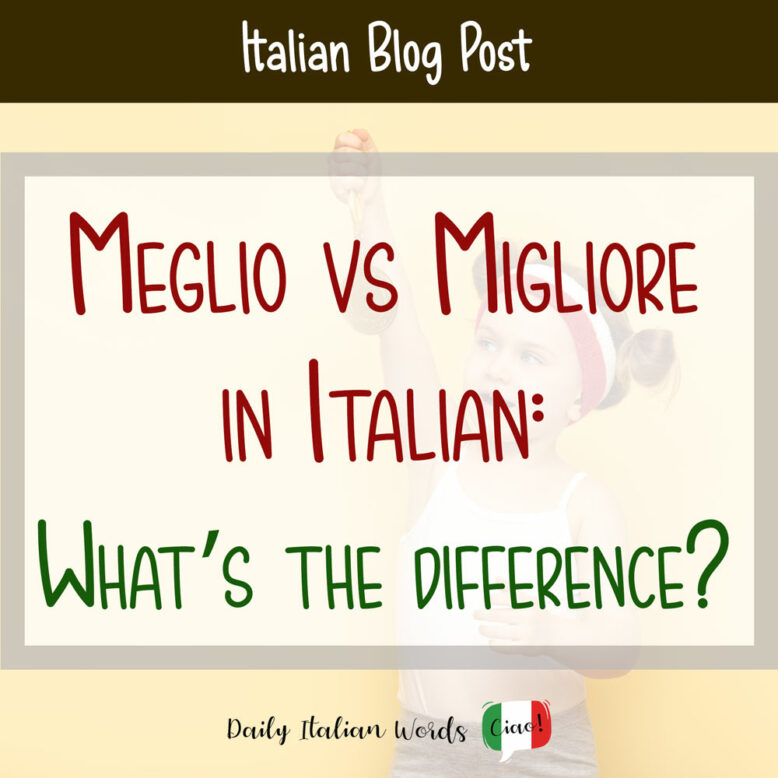The reason meglio and migliore are so difficult to use correctly is that both of them can mean better. Migliore, however, can also take the meaning of best.

A solution in simple words
A ready-to-use explanation to understand when and how to use meglio and migliore can be summed up in the following 3 points.
1. Meglio tells us how an action is performed. Therefore we need this word to make a comparison between two or more actions:
Parlo meglio l’italiano ora dell’anno scorso.
I speak Italian better now than I did* last year.
* in Italian, “I did” is implied
Per le ginocchia è meglio camminare che correre.
Walking is better than running for your knees.
2. We need migliore to compare two or more nouns, and these nouns can be anything: food, movies, people, songs, and so on.
Non c’è nessuno migliore di noi in questo settore.
No one is better than us in this industry.
Questo libro è migliore dell’altro.
This book is better than the other one.
3. Migliore takes the meaning of the best when it is preceded by an article.
Luca è il miglior amico che abbia mai avuto.
Luca is the best friend I’ve ever had.
Le migliori idee arrivano quando non le stai cercando.
The best ideas come when you’re not looking for them.
The in-depth explanation
The technical reasons for the difference we’ve just seen is that meglio and migliore, despite both being “comparative” words, belong to two different lexical categories.
1. Meglio belongs to the category of adverbs and it corresponds to più bene, literally more well. Well is an adverb, just like quickly, carefully, very, and so on.
Adverbs are invariable words that don’t refer to a person, an object or a situation, but to verbs (actions), adjectives, or other adverbs.
ADVERB
bene
well
COMPARATIVE
più bene = meglio
more well = better
Nel ristorante “da Gigi” ho mangiato meglio che nel ristorante “da Vito”.
I ate better at the restaurant “da Gigi” than I did at the restaurant “da Vito”.
*
ho mangiato meglio = ho mangiato “più bene”
I ate better = I ate “more well”
2. Migliore belongs to the category of adjectives and it corresponds to più buono/a literally more good.
Adjectives refer to a person, an object or a situation, but not to actions.
Remember that adjectives change their ending according to the gender and number of the elements they refer to. This is the reason why you will find migliori instead of migliore in the example below.
ADJECTIVE
buono
good
COMPARATIVE
più buono = migliore
more good = better
Le pizze di Gigi sono migliori di quelle di Vito.
Gigi’s pizzas are better than Vito’s.
*
Le pizze sono migliori di… = Le pizze sono più buone di...
pizzas are better than… = pizzas are more good than...
3. If you put a determinative article (il, lo, la, i, gli, le) before migliore, you distinguish the element it refers to from a group of similars. This is the so-called “relative superlative” and it takes the meaning of “the best”.
Clara è la migliore della classe.
Clara is the best in the class.
Antonio è il mio migliore amico.
Antonio is my best friend.
For a more in-depth explanation of the difference between bene and buono and their nature as adverbs and adjectives, I recommend reading this article: Bene, Buono, Bravo and Bello.
The opposites: Peggio and Peggiore
Everything that has just been explained about meglio and migliore is also applicable to their direct opposites: peggio (adverb) and peggiore (adjective) both meaning worse, and the latter also the worst.
ADVERB
bene
well
COMPARATIVE
più bene = meglio
more well = better
opposites
male
badly
più male = peggio
more badly = worse
ADJECTIVE
buono
good
COMPARATIVE
più buono = migliore
more good = better
opposites
cattivo
bad
più cattivo = peggiore
more bad = worse
Therefore, meglio and migliore can be replaced by peggio and peggiore in the previous examples to obtain the opposite sense.
Nel ristorante “da Gigi” ho mangiato peggio che nel ristorante “da Vito”.
I ate worse at the restaurant “da Gigi” than I did at the restaurant “da Vito”.
*
ho mangiato peggio = ho mangiato “più male”
I ate worse = I ate “more badly”
Le pizze di Gigi sono peggiori di quelle di Vito.
Gigi’s pizzas are worse than Vito’s.
*
Le pizze sono peggiori di… = Le pizze sono più cattive di...
pizzas are worse than… = pizzas are more bad than...
Than: Di or Che?
Being two comparatives, meglio and migliore put in relation at least two elements or situations.
In English, when both elements of a comparison are explicit in the sentence, the latter is preceded by than. In Italian the function of than can be taken by di or che.
The general rule requires di before a direct object (that is to say, when no other preposition as con, per su, in is needed) while che should precede verbs or when comparing adjectives.
Moreover di can become articulated (del, dello, della, delle, degli) if followed by nouns like objects or professions.
Let’s analyse a few examples both with di and che.
1. Than → DI
- Di + a personal name:
Alberto è uno studente migliore di Giorgio. = Alberto is a better student than Giorgio.
- Di + a direct personal pronoun
Mia nonna cucina meglio di me. = My grandma cooks better than me.
- Di + a demonstrative pronoun (questo, quello/ciò – this, that)
Questo è meglio di quello. = This is better than that.
- Di + adverbs
Non possiamo fare meglio di così. = We can’t do better than this.
Ora è meglio di prima. = Now it’s better than before.
- Di + ARTICLE + a noun:
Il film è migliore del libro. = The film is better than the book.
2. Than → CHE
- Che + a verb:
Dormire è meglio che dire stupidaggini. = Sleeping is better than talking nonsense.
- Che + a reflexive verb:
Forse ora è meglio che (io) me ne vada. = Now it’s better for me to go.
- Che when comparing adjectives:
Cotto è meglio che crudo. = Cooked is better than raw.
What happens in real life
As often happens, the everyday and informal way of speaking involves changes and sometimes simplifications. Let’s take a look at the two most popular trends.
1. The main trend is certainly the adjectival use of meglio instead of migliore with verbs likeessere / to be, sembrare / to seem and similar. Perhaps this happens because the similarity between the two words makes meglio a sort of “shortcut” for migliore, although it remains invariable (as adverbs do) and doesn’t really behave as a normal adjective.
La lana è meglio del cotone per questo tipo di maglione.
Wool is better than cotton for this type of sweater.
Questi risultati sono meglio di quelli prima.
These results are better than the ones before.
This extended use of meglio also applies to the relative superlative function of il migliore → il meglio = the best.
È il meglio che abbiamo.
It’s the best we have.
Queste pesche sono le meglio, assaggiale!
These peaches are the best, try them!
2. In everyday life, Italian speakers often prefer che (instead of di) for all kinds of comparisons.
Questo è meglio che quello (instead of: di quello)!
This is better than the other one!
Ora è meglio che prima (instead of: di prima).
Now it’s better than before.
Italian idioms and sayings with meglio and migliore
In order to familiarise yourself with meglio and migliore, it can be helpful to learn some of the most common expressions and idioms using these words. Some of these have an English equivalent, while others use a different form to express a similar concept. Let’s see 10 of them.
- Meglio tardi che mai → Better late than never.
- Poco è meglio di niente → A little is better than none.
- Il cane è il migliore amico dell’uomo → A dog is man’s best friend.
- Prevenire è meglio che curare → Prevention is better than cure.
- Di bene in meglio → Getting better and better / Di male in peggio → From bad to worse.
- Fare qualcosa “nel migliore dei modi” → to do something “in the best way”.
- Fare qualcosa “Alla bell’e meglio” → to do something “approximately”.
- Si stava meglio quando si stava peggio → we were better off when we had less / things were better when times were harder.
- Il meglio è nemico del bene → literally “the best (way) is enemy of well”, it can be reinterpreted in English as “Perfectionism can be counter-productive”.
- Meglio un uovo oggi che una gallina domani → literally “it’s better an egg today than a hen tomorrow”, its English equivalent could be: “A bird in the hand is worth two in the bush”.

Niccolò Curini has been teaching Italian since February 2016, primarily at the Language Center of the University of Goettingen in Germany. In this role, he led courses ranging from level A1 to B2. To qualify for this position, he obtained the DITALS certification, enabling him to teach Italian as a Foreign Language to university students. Social media: Instagram – Facebook – Twitter


